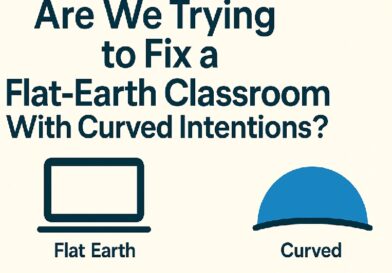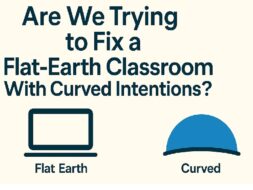Most school reforms fail for a simple reason: we are trying to fix a Flat-Earth Classroom with curved intentions.
Click HERE to read what the First Orbit is and Chapter 1 for free
A Flat-Earth Classroom is a place where learning is flattened into straight lines, time is forced into rigid boxes, subjects are trapped in silos, and thinking collapses into memorising, repeating, and performing. Every symptom we see in struggling schools—low morale, high behaviour issues, teacher burnout, disengaged learners—flows directly from this flat geometry. These are not the real problems; they are signs that the system itself no longer matches the curvature of the human brain.
When morale dips or behaviour spikes, schools often respond with new programs, parent workshops, leadership councils, or staff wellness days. These responses help temporarily. They soften the surface anxiety. They create movement. But they do not bend the system.
You cannot fix a flat structure with curved intentions.
Low morale, high discipline cases, and teacher exhaustion are not root causes. They are indicators of a deeper structural mismatch: a straight-line model trying to hold curved minds. Schools can repaint walls, roll out red carpets, redesign meetings, and launch community initiatives, yet the classroom remains fundamentally flat. The geometry has not changed.
In a Flat-Earth Classroom, learning follows the same predictable sequence: deliver → copy → remember → perform. The teacher becomes the engine of movement while learners become spectators, nodding along in the right places — gravity without a pull. This silent choreography is instantly recognisable because most teachers once performed it themselves. The habit continues across generations.
This is why behavioural programs and motivational campaigns don’t last. They treat the fever, not the cause. Culture collapses not because people fail, but because the geometry is wrong. Flat systems produce flat habits — habits that mute curiosity, silence questions, and reward mental shortcuts such as the “summary bargain,” where learners expect less for less: less thinking for less understanding.
Real transformation begins only when the classroom itself becomes curved. A Curved Classroom is not a program; it is a geometry. It is a space where thinking moves in orbits, where rhythm replaces pressure, and where cognition becomes a field rather than a funnel. It begins with Step Zero, the meta-cognitive pause that prepares the brain to orient and think. It continues through Thinking Tools, which convert thinking from an activity into a habit, giving learners maps for organising, relating, sequencing, and reasoning. It is reinforced by Chronosensor alignment, where learning follows natural cognitive rhythms instead of artificial urgency. And it is sustained by cross-silo thinking, where Maths, Science, and Language no longer compete for space but orbit meaning together.
In the Curved Classroom, learners stop being spectators. They become participants in their own thinking. Behaviour improves because curiosity is no longer suppressed. Burnout decreases because teachers stop being delivery engines and instead become designers of cognitive conditions. Engagement rises because the brain recognises its own geometry in the flow of learning.
Most schools invest in programs because programs are easy. They have logos, manuals, and launch dates. But programs end. Budgets end. Staff turnover resets everything. What endures are thinking habits — the only force strong enough to reshape classroom gravity.
Before starting another initiative, every school leader and teacher should pause and ask:
- Are we fixing the symptom or the structure?
- Is this classroom flat or curved?
- Do our learners think, or only perform?
- Are we cultivating thinking habits or compliance habits?
- Are we growing the Mothership of All Thinking — or feeding the machine?
Transformation begins not with a product, platform, or policy, but with thinking.
Thinking shapes habits.
Habits shape culture.
Culture shapes the future.
Schools don’t need more programs.
They need curvature — and that changes everything.







